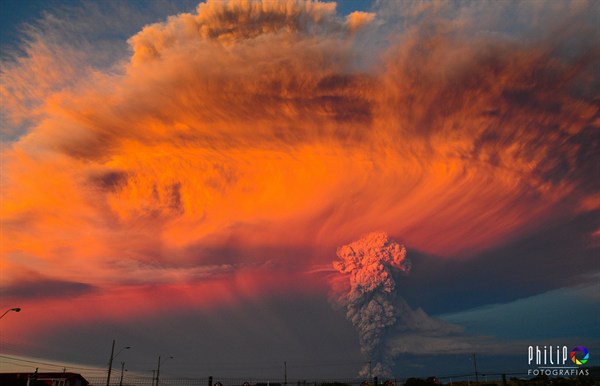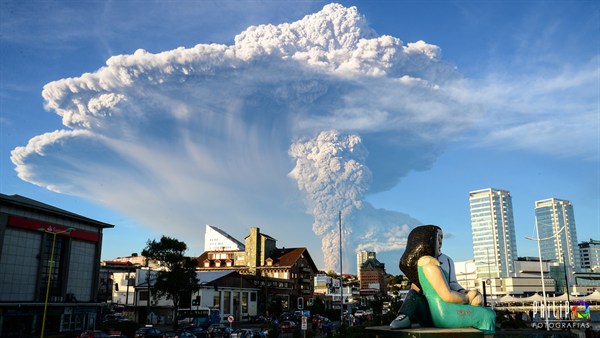What do volcanic eruptions mean for the climate?
Posted on 12 May 2015 by Guest Author
This is a re-post by Robert McSweeney & Roz Pidcock from Carbon Brief
Having lain dormant for over 40 years, the Calbuco volcano last night erupted twice within the space of a few hours. The blast sent a huge cloud of ash over southern Chile.
Carbon Brief has asked a number of experts what volcano eruptions mean for the climate, and whether or not we can expect this latest event to have global consequences.
Cooling effect
Volcanic eruptions can affect climate in two main ways.
First, they release the greenhouse gas carbon dioxide, contributing to warming of the atmosphere. But the effect is very small. Emissions from volcanoes since 1750 are thought to be at least 100 times smaller than those from fossil fuel burning.
Second, sulphur dioxide contained in the ash cloud can produce a cooling effect, explains Prof Jim McQuaid, professor of atmospheric composition at the University of Leeds:
"Sulphur dioxide is quickly converted into sulphate aerosol which then alongside the fine volcanic ash forms a partial barrier to incoming solar radiation"
You can see this in the NASA video below that maps movements of particles in the Earth's atmosphere. At around 2 minutes in you can see the impact of the volcanic eruption in Madagascar, just off the eastern coast of Africa.
Airborne particles in Earth's atmosphere. Credit: NASA
Explosivity
Not all volcano eruptions are the same. Volcanic eruptions are rated from zero to eight on a scale of explosivity, measured by the amount of ash and debris they produce.
Before Calbuco, the most recent significant volcano eruption was Mount Pinatubo in the Philippines in June 1991. This was rated as a six, while the first of the Calbuco eruptions has been rated as a four or five, according to a minister of the Chilean Government.
Calbuco volcano eruption. Credit: Philip Oyarzo Calisto
The characteristics of the ash cloud largely determine whether an volcanic eruption influences the climate or not.
One important factor is how high it reaches in the atmosphere, Prof Richard Allan, professor of climate science at the University of Reading, tells Carbon Brief:
"If a volcanic eruption is large enough to reach the stratosphere - above 8km in polar regions and above 15km in tropical regions - the absence of weather at these altitudes means that the injected aerosol particles can stick around for a number of years, reflecting sunlight back to space and cooling the planet."
The Pinatubo ash cloud extended 35 kilometers into the atmosphere, cooling parts of the world by up to 0.4C for two years after the eruption.
It's not just the spectacular eruptions that can affect the climate. Recent research has suggested that even small eruptions could be contributing to slower surface temperature rise in the last 15 years or so, compared to previous decades.
Satellite images suggest the Calbuco ash cloud has reached at least 14km, Dr Anja Schmidt, a researcher in volcanic impacts and hazards at the University of Leeds, tells Carbon Brief.
Climate impacts
Another important factor in whether a volcanic eruption influences climate is the amount of sulphur dioxide contained in the dust cloud. And the quantities can be huge. The recentBárðarbunga and Holuhraun eruption in Iceland are estimated to have produced as much sulphur dioxide as the whole of the European Union did in 2014, notes McQuaid.
Once in the stratosphere, fast-moving winds can quickly spread the ash cloud around the world, giving a local eruption a global impact.
It's early days but previous experience suggests the Calbuco eruption won't be producing such large amounts of sulphur, Schmidt explains:
"Based on eruptions of other Chilean volcanoes, like Chaiten or Puyehue Cordon Caulle, huge emissions of sulfur dioxide are not expected, or supported by the satellite data."
The geographical position of Calbuco may also restrict any global impact, Schmidt says:
"Global climate impacts are also unlikely due to the southern latitude of the eruption, but if the sulphur dioxide mass emission rate were to increase this eruption may temporarily enhance the aerosol particle concentrations in the upper troposphere and lower stratosphere."
Schmidt says right now, the priority is to ensure aviation safety by monitoring and predicting how the ash cloud disperses.
Tropical rainfall
Volcano eruptions can influence more than just temperature. Recent research suggests eruptions can affect the position of the Intertropical Convergence Zone (ITCZ), a huge belt of low pressure that is the main source of rain for much of Africa.
This has implications for weather in the Atlantic Ocean, as Dr Doug Smith, who leads decadal climate prediction research at the UK Met Office, tells Carbon Brief:
"If the eruption occurs predominantly in one hemisphere then we would expect the ITCZ to shift away from that hemisphere. So in this case, the ITCZ could shift northwards, which would tend to promote rainfall in the Sahel but also enhance Atlantic hurricane activity."
The impacts could also reach the Pacific Ocean and affect the El Niño event that's currently brewing there, says Smith:
"There are also signs that volcanoes may promote El Niño conditions for a year or two, possibly followed by a tendency towards La Niña. There already looks to be an El Niño building, so maybe this volcano would enhance that?"
Calbuco volcano eruption. Credit: Philip Oyarzo Calisto
A research opportunity
It may be a while before the full impacts of the Calbuco eruption reveal themselves, says DrMichael J. Pavolonis, a specialist in volcanic clouds at the US National Oceanic and Atmospheric Administration:
"This is an ongoing eruption ... it is too early to draw any conclusions regarding climate impacts."
But if it does turn out to be significant, scientists will have a unique research opportunity. Monitoring the impact of eruptions helps climate scientists refine models that project how the climate will respond to human-caused greenhouse gas emissions, explains McQuaid.
Volcanic eruptions that reach the stratosphere also give scientists a glimpse of what geoengineering techniques could do, he adds:
"It has been suggested that it may be possible to cool our climate through Solar Radiation Management schemes, which aim to artificially generate a negative forcing through the deliberate injection of material into the stratosphere."
Geoengineering is very controversial topic, with many unknown consequences, says McQuaid. Studying volcanic eruptions may be the closest scientists can get to a global experiment without the risks.































 Arguments
Arguments
































Nitpick: Maybe change the first sentence of the post to indicate that Calbuco erupted on April 22, 2015, rathe than last night.
Just to note that this article relates to 'normal' volcanic eruptions. Regular visitors to this site will recall there have been several articles on Large Igneous Provinces that have occurred rarely in Earth's past, were colossal, and which generated dire environmental consequences including global warming. Some article links: here and here and here.
LIPs are an altogether different phenomenon than normal volcanic eruptions.
There have also been Supervolcano eruptions much larger than 'normal' volcanic eruptions (but much smaller than LIPs) as summarised by the USGS here.
I put together this handy dandy graphic so people can get an idea of the relative scale of these things. The area of each circle represents the volume of lava erupted.
[RH] Resized image. Remember to keep images down to 500px.
That's a very useful little diagram Howard.